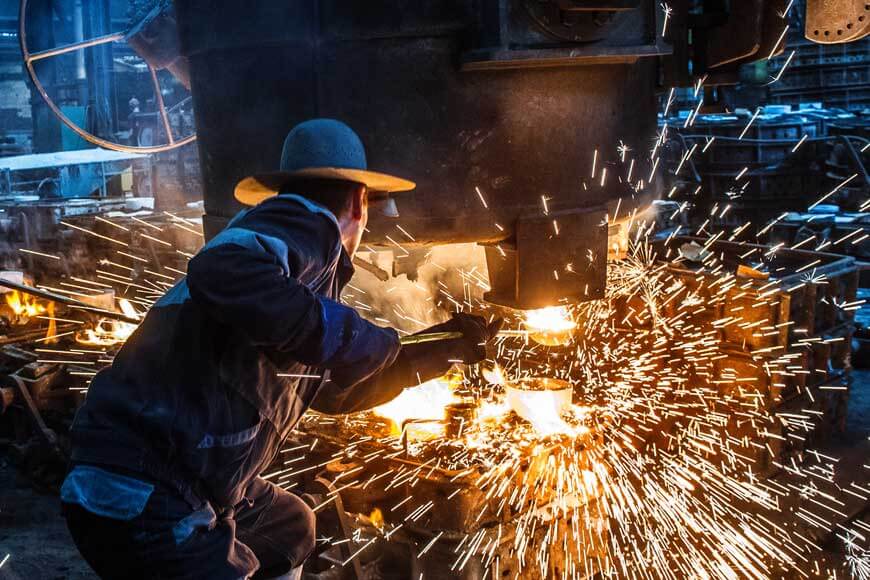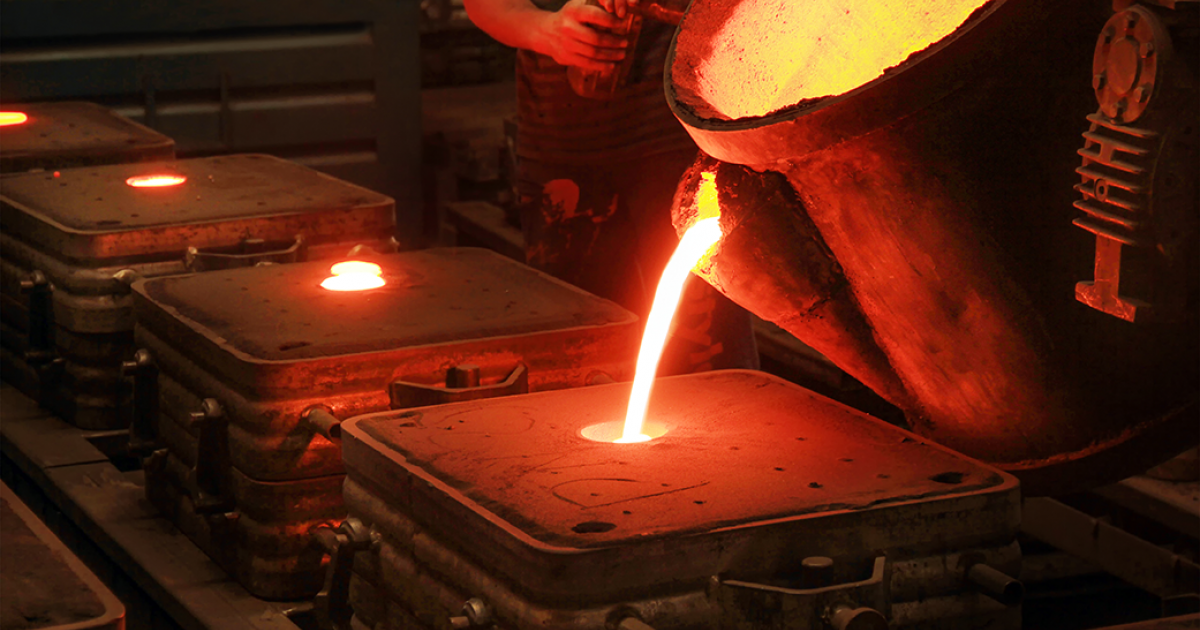Top 5 Reasons to Choose a Metal Foundry for Specialized Projects
Wiki Article
All About Metal Casting: Just How Foundries Supply Top Quality and Precision in Manufacturing
Metal casting stands as a foundational procedure in manufacturing, where raw metals are changed right into certain components. Foundries employ different casting methods to achieve preferred attributes and shapes. Each approach features its very own set of limitations and advantages. Recognizing these subtleties is vital for valuing just how quality and precision are maintained throughout the process. The conversation ahead will certainly explore the complex dynamics of metal casting and its relevance across several markets.The Basics of Metal Casting
Metal casting is a basic process in producing that entails shaping molten metal into desired forms. This vital method begins with the option of raw products, frequently numerous metal alloys, which are thawed in a furnace. When the metal reaches the proper temperature level, it comes to be liquid and all set for casting.The process calls for a mold and mildew, commonly made from sand, metal, or ceramic, which specifies the final form of the actors things. As soon as the molten metal is put into the mold, it cools down and strengthens, handling the mold and mildew's shapes.
After cooling, the casting is eliminated from the mold and mildew, and any required completing procedures, such as polishing or trimming, are carried out. This technique allows makers to produce intricate shapes and parts with high precision and marginal waste. Metal casting is extensively made use of throughout different sectors, from automobile to aerospace, emphasizing its value in modern production.
Sorts Of Casting Approaches
While different casting techniques exist, each method is and provides special advantages matched for different applications. Sand casting, one of one of the most usual approaches, makes use of sand as the mold product, permitting large components and complex layouts. Investment casting, known for its precision, utilizes a wax pattern coated in ceramic, making it excellent for complicated geometries. Die casting, which involves forcing molten metal into molds under high pressure, is regularly utilized for automation of tiny, in-depth elements. Furthermore, covering molding integrates sand and resin to produce thinner, much more accurate mold and mildews, improving surface finish. Another approach, constant casting, allows the manufacturing of long sizes of metal shapes, streamlining production processes. Each of these methods plays an essential duty in the metal casting industry, resolving details demands from production volume to make complexity, consequently adding to the diversity of applications across various markets.The Role of Foundries in Production
Foundries serve a vital function in the manufacturing landscape, as they change raw metals right into useful elements through different casting procedures. These facilities employ an array of techniques to produce items that meet specific specs, thus guaranteeing high quality and effectiveness in production (Aluminum Foundry). By making use of approaches such as sand casting, investment casting, and die casting, factories deal with diverse industries, including automotive, aerospace, and building
Inevitably, shops are important to the manufacturing ecosystem, giving important elements that support a large variety of markets and applications. Their precision and versatility drive efficiency in contemporary production.
Products Used in Metal Casting
The option of products made use of in metal casting is crucial for accomplishing the preferred residential properties and performance of the last product. Numerous steels such as aluminum, iron, and bronze are typically utilized, each offering distinct benefits. Aluminum is preferred for its lightweight and corrosion-resistant qualities, making it optimal for automotive and aerospace applications. Iron, specifically cast iron, is understood for its superb fluidness and strength, appropriate for heavy equipment and facilities elements. Bronze, with its superior wear resistance, is often used in marine atmospheres.In addition, products such as silica sand are regularly utilized for mold and mildew making, giving a great equilibrium in between sturdiness and convenience of shaping. The selection of materials likewise consists of additives like changes, which boost the casting process by improving fluidity and lowering oxidation. Eventually, the suitable choice of these materials significantly influences the effectiveness and quality of the casting procedure.
Quality Control in the Casting Process
Quality assurance in the casting process is important to ensure that last items fulfill industry standards and specs. Various evaluation methods are used to recognize flaws and evaluate the honesty of actors components. In addition, adherence to developed certifications and criteria improves the dependability and efficiency of actors materials.Examination Techniques Employed
Preserving the honesty of actors metal parts counts heavily on different inspection methods. Foundries utilize aesthetic examinations as an initial procedure to identify surface flaws, such as cracks or inclusions. Non-destructive screening (NDT) techniques, including ultrasonic testing and radiographic evaluation, are essential for discovering inner problems without jeopardizing the element's stability. Dimensional inspections using calipers and coordinate measuring devices verify that components meet defined resistances. Additionally, chemical analysis verifies that the alloy composition aligns with needed standards. These assessment methods jointly confirm that the spreadings fulfill the necessary top quality and performance criteria, inevitably decreasing the threat of failing in their intended applications. Applying these strenuous inspections is basic for preserving high requirements in metal casting production.Requirements and Certifications
Standards and accreditations play a vital duty in the top quality control of the casting procedure. Foundries adhere to various worldwide and industry-specific criteria, such as ISO 9001 and ASTM standards, guaranteeing consistency and dependability in their items. These standards outline the needed standards for materials, manufacturing approaches, and screening treatments, adding to a more reliable production blog here process. Qualifications, such as AS9100 for aerospace applications, better stress the importance of quality control in specialized fields. By acquiring these credentials, foundries show their commitment to quality, improving and decreasing problems client fulfillment. Normal audits and evaluations validate conformity, promoting continual enhancement and advancement within the sector. Eventually, adherence to developed criteria grows trust fund in between customers and suppliers.Innovations in Casting Technology

3D Printing Assimilation
Incorporating 3D printing modern technology right into metal casting procedures is changing the production landscape. This look what i found innovative fusion improves the style and production of complex geometries that typical techniques battle to achieve. By employing additive production for developing mold and mildews and cores, factories can considerably minimize lead times and product waste. 3D printing permits for rapid prototyping, allowing makers to examine layouts swiftly and efficiently, thus assisting in repetitive enhancements. This innovation additionally supports the manufacturing of lightweight components, which are essential in sectors like aerospace and vehicle. Because of this, the integration of 3D printing not only streamlines procedures yet also boosts the precision and high quality of actors metal items, noting a notable advancement in the industry.Automated Manufacturing Processes
The developments in 3D printing have actually led the way for further technologies in automated production processes within metal casting. Foundries are significantly adopting robotics and automation to boost performance and precision. Automated systems simplify the whole casting workflow, from mold development to pouring and completing. Smart sensing units and real-time tracking allow for specific control of temperature levels and material flow, decreasing waste and enhancing quality. Furthermore, software program solutions assist in far better design and simulation, allowing manufacturers to enhance processes prior to manufacturing starts. These automated manufacturing processes not only lower labor prices yet additionally reduce human error, making certain regular outcome. Because of this, the combination of innovative innovations in metal casting is reinventing production capabilities and fulfilling the growing needs of different sectors.Advanced Material Advancement
As markets require higher performance and sustainability, innovations in material development for metal casting are becoming a critical focus. Engineers and researchers are discovering brand-new alloys and compounds that boost mechanical homes while minimizing ecological influence. Technologies include light-weight products that keep stamina, allowing far better fuel performance in transportation applications. Additionally, the incorporation of recycled materials is becoming more widespread, straightening with sustainability objectives. Advanced casting techniques, such as 3D printing and precision molding, permit the creation of intricate geometries that typical methods can not achieve. These developments not just improve the performance of cast elements however likewise improve manufacturing efficiency. In general, the continual evolution of product scientific research drives the future of metal casting, fulfilling the needs of modern-day industries.
Applications of Metal Casting Across Industries
Metal casting plays an important duty in various industries, as it enables for the manufacturing of complicated forms and top notch elements with relative performance - Aluminum Foundry. In the auto industry, cast metals are crucial for producing engine blocks, transmission instances, and various other crucial components that require toughness and precision. Aerospace markets utilize metal casting for elements like turbine blades and useful link structural elements, where reliability is extremely importantFurthermore, equipment and equipment production benefit from metal casting by producing equipments, real estates, and other elaborate parts that improve performance. The construction sector likewise uses metal casting for building functions, architectural supports, and fittings, showcasing convenience.
The clinical area counts on actors metals for surgical instruments and implants, stressing the requirement for biocompatibility. Overall, metal casting is a fundamental procedure throughout multiple markets, providing services that fulfill strict quality requirements and performance demands.
Regularly Asked Inquiries
What Safety And Security Measures Are Absorbed Metal Casting Foundries?
In metal casting shops, safety and security steps consist of safety equipment, air flow systems, routine equipment upkeep, employee training, and emergency situation protocols to mitigate dangers related to high temperatures, dangerous products, and potential accidents during the casting procedure.Exactly How Do Foundries Handle Waste and Environmental Effect?
Foundries take care of waste and environmental impact with reusing products, implementing purification systems for discharges, and sticking to laws - Aluminum Casting. They also adopt lasting methods, such as lowering power intake and making use of environmentally friendly compounds in their proceduresWhat Are the Expenses Associated With Metal Casting Procedures?
The prices linked with metal casting processes include basic materials, labor, devices upkeep, energy intake, and waste management. Furthermore, changes in market value and compliance with environmental policies can significantly impact overall costs for shops.How Does Metal Casting Compare to Various Other Production Approaches?
Metal casting provides unique advantages, such as intricate forms and high product efficiency, contrasted to approaches like machining or stamping. Nevertheless, it might involve much longer preparations and greater preliminary costs, depending upon task requirements.
What Occupation Opportunities Exist in the Metal Casting Industry?
The metal casting sector offers numerous occupation possibilities, including factory administration, process design, high quality guarantee, mold layout, and equipment procedure. Specialists can also pursue duties in r & d, sales, and ecological health and wellness and safety.Metal casting stands as a fundamental procedure in production, where raw metals are transformed right into particular elements. Metal casting is a basic procedure in manufacturing that includes forming liquified metal into wanted forms. Another method, continuous casting, enables the production of long sizes of metal forms, simplifying manufacturing procedures. The prices connected with metal casting procedures consist of raw materials, labor, devices maintenance, energy intake, and waste management. The metal casting industry uses different job possibilities, consisting of foundry management, procedure design, high quality guarantee, mold and mildew style, and device operation.
Report this wiki page